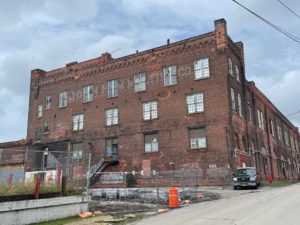The John Kam Malt and Kiln House at 356 Hertel Avenue in Black Rock is on its way towards a mixed-use future. Eighty apartments, a self-storage facility and 14,000 sq.ft. of retail/service space are planned. The building will also include a co-working space, seventh-floor patio, dog park and wash station, bicycle storage and an event space.
The project is being undertaken by Fred LoFaso and designed by Studio T3 Engineering. Sienna Realty is handling commercial leasing.
The 130,000 square foot building is on the State Registry of Historic Places and is seeking nomination to the National Register. Some background information on the property:
The John Kam Malting Company was one of the largest malt producers in the United States in the nineteenth and early twentieth century and is significant in Buffalo’s long beer brewing history. It is the only remaining example of the Dornfeld drum and kiln system sub-type of malthouse architecture in Buffalo.
The building was designed by John F. Dornfeld, the engineer who also patented the innovative pneumatic drum germinating system and pneumatic kiln technologies utilized at the site. The organization of the interior spaces and architecture, which retain a high degree of integrity, is specifically determined by, and inclusive of, these systems.
In the late nineteenth century as the production of beer in Buffalo was increasing dramatically, John Kam’s malting complex on Genesee and Pratt Street was no longer able to produce the quantity of malt necessary to meet growing market needs. “Mr. Kam determined upon building a new plant and, after consideration of a large number of sites, settled upon a large plot of ground at Black Rock, …This land is at the crossing of the Belt Line tracks of the Central and main line of the same road, running to Niagara Falls. It is bounded on the west by the Niagara Falls tracks of the Central and on the south by Hertel avenue and the Belt Line tracks.” The plant that Kam intended on building would be a “gigantic structure,” “first-class in all respects.” Kam engaged John F. Dornfeld, who had recently left the Galland-Henning Company, so it is highly probable that this was one of the first commissions of the J.F. Dornfeld Company.
John Kam, who was considered “one of the pioneers of the malting industry in Buffalo,” was born in Pleistein, Bavaria in 1833, where he was trained as a brewer and maltster. He emigrated to Buffalo in 1855 and worked as the brewmaster for the Jacob Scheu Malting Company at Genesee and Spring Streets. In 1860 he started his own bakery, which he ran until 1869 when he started a small malt house adjacent to the bakery. With the success of the malting business, he constructed a building at Genesee and Pratt Streets in 1872, which he enlarged in 1879, and again in 1884.
In 1889 he founded the John Kam Malting Company with his sons Joseph, Henry, and John Jr. Joseph, who was on the board of the German American Bank, and owned the Exchange Elevator Company, was secretary, and Henry was an executive in the company. John Jr., the youngest, was a student at Canisius College and would later join the firm and become general manager. In 1898 it was “one of the largest privately-owned commercial enterprises in Buffalo,” with a capacity of 600,000 bushels annually, which were all floor-made. To meet the demand for malt, the company constructed a large malt house on Hertel Avenue in 1901.
The John Kam Malting Company Malt House and Kiln House on Hertel Avenue incorporated the technologies of the Dornfeld Pneumatic Drum System and Pneumatic Kiln House and, at the time, was the largest pneumatic drum malting system in Buffalo, and the “biggest malt house on earth.” The capacity of the new malt-house had increased dramatically to 2,000,000 bushels per annum.
Following John Kam’s death in 1905 his sons continued operation of the company, utilizing both the Genesee and Pratt complex, where the compartment system of malting was used, and the facility on Hertel Avenue where the pneumatic drum and kiln system was used. The John Kam Company continued to thrive, and the business was one of the largest malting enterprises in the city of Buffalo and the country.
In late 1918 the Oswego Milling Company purchased the John Kam Malting Company plant on Hertel Avenue. Dornfeld’s pneumatic kiln house was utilized by the new company, retaining the apparatus that defined and remains a part of the architecture. The large pneumatic drums were removed from the structure and shipped to South American and Mexican firms. Today, their presence is still evident in the architectural volume and ghosting that provides architecturally specific evidence of the Dornfeld drum system sub-type.
Get Connected: Meredith Battin, Sienna Realty- 716.228.6187
The post Construction Watch: 356 Hertel appeared first on Buffalo Rising.

